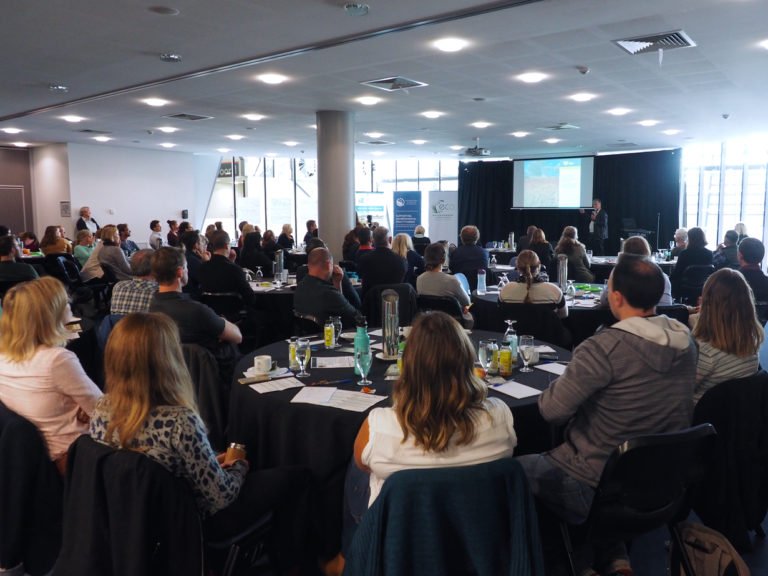Chris and I each attended a day of this Symposium that aimed to explore the issues surrounding flora and vegetation surveys in Environmental Impact Assessment (EIA) in WA and beyond. It was jointly hosted by the Environmental Consultants Association (ECA) and the Environmental Institute of Australia and New Zealand (EIANZ).
Over 120 people attended over the 21st and 22nd June 2018, coming from as far afield as Kalgoorlie, Karratha and NSW and including representatives from the three levels of government, EIA practitioners, botanical (and zoological) consultants, universities, community groups and mining companies.

A full house (thanks to ECA for the image).
DAY 1
Session 1: a panel discussion by representatives from the Department of Water and Environmental Regulation (DWER), Environmental Protection Authority (EPA) Strategy and Guidance, Department of Mines, Industry Regulation and Safety (DMIRS) and the Federal Department of Energy and Environment (DoEE) discussing guidance materials, scope and quality of survey reports, indirect impacts, assessment time-frames and strong advice to consult with agencies early.
Session 2: community involvement in botanical EIA including how they are conducted on public lands, the responsibilities that consultant botanists have more broadly in EIA.
Session 3: legal frameworks that govern botanical EIA, including clearing regulation history and updates to the drafting new Biodiversity Conservation Act 2016 regulations (due to come into effect on the 1st January 2019).
Session 4: technical discussions with a specialist flora and vegetation consultant views on ensuring robust technical surveys, followed by EPA’s expectations of botanical survey reports and discussion with representatives from the WA Biodiversity Science Institute on leveraging aggregated biodiversity data.
DAY 2
Session 1: practitioners views on how flora and vegetation surveys operate within EIA process, including a NSW perspective from guest-speaker Dr John Hunter and an end-user perspective from WA consultant Kelli McCreery.
Session 2: national flora taxonomy initiatives by Dr Kevin Thiele including the Decadal Plan for Taxonomy, and case studies from Malcolm Trudgen and Geoff Cockerton illustrating how much more there is to know about our flora.
Session 3: challenges in classifying and describing our vegetation reliably and comparably, including the rationale behind plot-based surveys and the science of phytosociology that might underpin them. Greg Keighery elaborated on the (sometimes poor) definition of Threatened and Priority ecological communities (TECs and PECs).
Session 4: covered allied knowledge domains such as WA soil and geology, and the need for fungi to be included in surveys for EIA. The symposium was then wrapped up with a group discussion.
Some important issues that came up during the conference (from our perspective) included:
- environmental consultants and regulators rely on quality data/information to do their jobs well; this event was in part to help each understand the others’ data/info needs that could streamline approvals;
- consultants were trying to find out what causes delays in approvals, and where to find guidelines and standard practices;
- regulators were acknowledging being swamped and behind but stressed the importance of early dialogue and providing good quality data (eg. targeted data against the key flora/fauna objectives for that specific project area);
- understanding the ramifications of requirements for survey compliance and report submissions (eg. IBSA)
- reviewing the current data collection methods (pen/paper, tablets, phones etc.);
- the need for standardisation of data capture;
- solving the apparent lack of information defining WA’s TECs and PECs;
- lobbying for reliable ongoing taxonomic resources — for identification, names data, and the circumscription of new species, such as the work of the WA Herbarium and FloraBase, for a national maintained and comprehensive eFlora; or for the WA Biodiversity Science Institute.
If you’d like to know more about how we can help you with developing systems for capturing, managing or analysing environmental data, then please leave a comment below – or email us directly: alex.chapman@gaiaresources.com.au or Chris.Roach@gaiaresources.com.au.
Alex and Chris

Comments are closed.